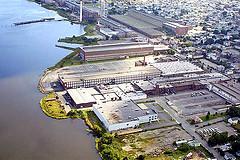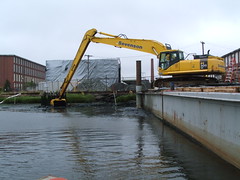History of EPA Involvement at the Aerovox Mill
You will need Adobe Reader to view some of the files on this page. See EPA's About PDF page to learn more.
On this page you will find:
- Why is EPA involved at Aerovox?
- 2010 Settlement Clears Funding for Demolition
- Additional Site History and Early Cleanup Information
Why is EPA involved at Aerovox?
The Aerovox building was used for electrical component manufacturing from the 1940's until about 1978. Operations and disposal practices contaminated soil, surface water runoff, groundwater and building materials and equipment with PCBs and solvents.
This 450,000 sq. ft. building is on about 10 acres of industrial land beside the Acushnet River. EPA has been actively sampling the building, surrounding soil and groundwater to help guide the best cleanup approach while ensuring that the building demolition is performed safely for the surrounding community.
2010 Settlement Clears Funding for Demolition
In April of 2010, EPA announced a significant milestone that ensured the vacant mill could finally be taken down. EPA, alongside the Massachusetts State Department of Environmental Protection, and the City of New Bedford came to a simultaneous settlement which outlined the responsibilities of AVX Corporation and the authorities and oversight roles of the federal, state and local government to clean up the site. EPA will oversee the entire building demolition to ensure it is done in compliance with stringent environmental standards and that work progresses in a manner that is as protective as possible for the surrounding communities.
EPA reached a settlement with AVX Corporation to cover the oversight and demolition portion of work at the site. In addition to the settlement with EPA, AVX also came to an agreement in principle with the Commonwealth of Massachusetts and the City of New Bedford to ensure that the soil and groundwater at the site is further evaluated and remediated under the state’s hazardous waste site cleanup program before ultimately being turned over to the City.
Through these two additional agreements, the extent of contaminated soil and groundwater will be assessed, additional site cleanup and/or capping needs will be evaluated and long-term groundwater monitoring and cap maintenance will be performed. In addition, the City-AVX settlement provides for installation of a clean utility corridor to streamline potential future redevelopment of the site and creates a cost-sharing approach for a shoreline greenway.
In June of 2010, planning and procurement activities for the building dismantling began. Following significant work to empty the inside of the building, and safely decommission all utilities, the actual dismantling of the building is expected to begin in the fall 2011.
Additional Site History and Early Cleanup Information

Polychlorinated biphenyls (PCBs), banned as of 1977, are a class of man-made chemicals that were used for many years at the Aerovox mill in the manufacture of capacitors for electronic devices. EPA had reached a settlement with the prior owner of the Site, Aerovox, Inc., to perform the demolition and capping, but Aerovox’s subsequent bankruptcy in 2001 lead to significant delays in addressing the site.
In 1997, after the identification of very high levels of PCBs within the interior of the building and the presence of PCBs in uncapped soils outside the building, Aerovox, Inc. (Aerovox) prepared the 1998 Engineering Evaluation/Cost Analysis (EE/CA) (PDF) (283 pp, 15.8 MB). The 1998 EE/CA evaluated three alternatives for demolishing the building, disposing the demolition waste, and capping the entire site. In 1999 EPA entered into an Administrative Order on Consent with Aerovox pursuant to the Resource Conservation and Recovery Act (RCRA) to perform the cleanup recommended in the 1998 EE/CA. In April 2001, Aerovox relocated to a new facility and in June 2001, filed for bankruptcy. The building demolition and capping in the RCRA Order was thus not performed and the building has remained vacant since April 2001. The EPA settled its claim in the bankruptcy and the proceeds, although insufficient, will contribute to the site's cleanup.
Site risks remain consistent with those presented in the 1998 EE/CA, with PCBs in soil and groundwater posing a potential risk to human health and the environment. In addition, the long-term vacancy of the building poses a possible fire threat. Since Aerovox vacated the building, significant deterioration has occurred including increased roof leaks and heavy water damage throughout the building. Trespassing and vandalism (and the potential for tracking contamination off-site) have been a recurring problem.
In April 2006, after securing additional funding to supplement the bankruptcy proceeds, the EPA prepared a Supplemental EE/CA (PDF) (45 pp, 1.8 MB) to a) update the cost estimates of the 1998 EE/CA, b) evaluate two new alternatives for the site, and c) allow additional public comment on these issues. In response to the public comments received, EPA has selected building demolition with off-site disposal of the demolition debris and site capping as the remedy for the federal portion of the site's cleanup. On January 27, 2010 EPA finalized the official Non-Time Critical Removal Action at the site which incorporated these cleanup elements.
EPA has sampled building materials, groundwater and asphalt at the site. As part of these additional efforts, elemental mercury was identified in the building, used as controls and switches within the mill, some of which had spilled onto the floor. In December of 2007, about 25 pounds of mercury had been removed, and an additional 1,000 pounds of mercury and associated debris was removed and disposed offsite in February and March of 2008.
Other previous efforts by the EPA include:
- June-July 2008, about 7,500 cubic yards of highly contaminated sediment was removed from the shoreline along the Aerovox mill. This material has been stabilized with cement and is currently stored in a lined storage cell at EPA's Sawyer Street facility.
- A Conceptual Site Model assessment (including groundwater and surface water run-off sampling) in March 2006.
- April 2004 – November 2004 drum removal
- Sampling for PCBs in the asphalt parking lot in spring 2004
- 178 samples were taken from equipment and building material to explore what demolition debris might be recycled.
- Ground penetrating radar was used to help EPA identify utility pipes and lines that will require protection once demolition is underway.
- Building demolition specialists have been consulted to ensure that the future deconstruction plan is safe and protective.
- Annual groundwater monitoring continues to be performed.

